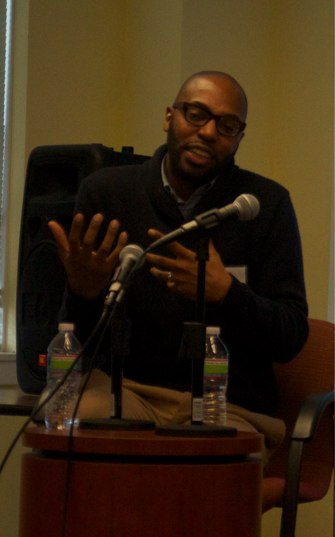Some might wonder about the sanity of taking a late afternoon flight out of Fort Worth, later arrival at the hotel, an almost descent night’s sleep, all to attend only the last day of Educon 2.4. What I wonder about is the potential malign effects of three whole days of deep and enthrawling conversations, nearly every one pushing my thinking in subtile or dramatically new directions.
I reminded Chris Lehmann, at the end of the last session, that I talk about this stuff just about every day. Then I confessed that there was a moment during the afternoon that I realized that every contribution I had made the entire day had come from something else I’d heard at the conference. Educon is a cauldron where our ideas about education get stirred up and mixed with those of others. Our concepts get disassembled and recombined through forces of attraction and repulsion that dazzle me, and every time it happened, it left me a little stunned for a moment.
The one complaint that I have about the Educon experience is the inability to spend at least 15 minutes reflecting after every conversation. I am not referring to the larger conversation sessions, but every single conversation with every single person I encountered, in the sessions, in the hall, fixing coffee, checking my coat ….
This is what I hope to be the first of my Educon reflections about what I learned, unlearned, and relearned. ((“The illiterate of the future are not those that cannot read or write. They are those that cannot learn, unlearn, relearn.” – Alvin Toffler))
 |
| Chris Emdin compellingly making his point |
The first formal part of the Sunday installment of Educon was the large group panel discussion, entitled, “How do Schools Sustain Innovation?” I found myself feeling a bit sorry for the moderator, Kevin Hogan, because the panelists pretty much took off from the start and didn’t land again until Chris Lehmann had to fairly frantically call for an end.
It struck me during the discussion, that innovation – a means of finding or inventing a new and better way of accomplishing a goal (my definition) – has become “a goal.” This is understandable within the education arena, because being an inventive, resourceful, free-thinking goal-achiever is part of the skill-set that we are coming to consider basic. But innovation for innovation’s sake risks going down the same confusing road of technology for technology’s sake. It gets taken apart, sequenced, classified, curriculumized — and it simply stops making sense. Chris Emdin pointed this out when he suggested that innovations can get cooped, branded, and become dogma. One of the many threads that I rode throughout the day was that there is no one-size-fits-all “vision” for schooling.
To me, the question at hand is, “How do we sustain an innvoation-friendly school?” and even though the general discussion was riveting, I did not get any clear message on how this is done. So at some point, I started a branch on the concept map I was using to take notes where I added and eventually sorted a list of principles or process for sustaining an innovation-friendly environment.
At the heart is permission and facility. An educational community that adapts to changing conditions grants its members permission to innovate and facilities or procedures for pursuing a better way. It is part of the school’s culture.
Here is the list that I ended with. Even though it is numbered, I now see that other arrangements are at least as appropriate as this.
- Permission to Identify and Describe a Problem
- Permission to Solve the Problem
- Willingness to Let Go
- Awareness of Other Boxes
- Engineer a New Way
- Permission to fail and re-engineer
I added permission here because several times during the day people described environments that were unwilling to admit problems or listen to those who suggested any course other than “business as usual.”
This one might actually be tougher to allow than it seems. Having worked in state government, I know how risky it is to do anything that jeopardizes your reputation – or that of your boss. In some environments, it is your job to make your boss look good.
This one might better be labeled, “Permission to take a Chance.”
I suspect that many worthwhile innovations fail, because they are simply mounted on top of existing practices, rather than transforming existing practices. This is illustrated by the three challenges, made by American education reformers, to the Finnish education model (see Finnish Miracles and American Myths). The U.S. education reform movement seems unwilling to consider letting go of government testing, school competition, and accountability.
This is a bit of a twist from my usual reference to “outside the box” thinking. It was actually sparked by a previous conversation with the Director of Applications Development at a large school district I recently worked in. He told me that what he looks for in prospective hires for his programming staff is “creativity.” He went on to say that the best part of his education was all of the history, literature, science, etc. that he took.
I think that innovation does not necessarily come from outside the box, but from having access to other boxes that rearrange our perspectives and enable us to come at a problem from a different angle.
This, I guess, is where the innovation happens, and much has been written about this by smarter people than me. I will humbly suggest that it requires research, design, collaboration, negotiation, and flexibility, to mention only a few of the skills.
This may well be the toughest part to accomplish. Innovation in business and industry are easy. Failure in the public sector is fuel to those with political agendas. In the private sector, R & D are considered a legitimate and necessary cost of doing business. For schools, it is a waste of tax-payer money. You can tell that I speak from some experience here.

 A couple of weeks ago, I started a blog post recalling a course that I once took as part of my Masters degree. The 1992 course was about developing applications using dBase (
A couple of weeks ago, I started a blog post recalling a course that I once took as part of my Masters degree. The 1992 course was about developing applications using dBase (

